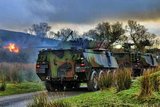DARPA details next phase of ALIAS programme
The Defense Advanced Research Projects Agency (DARPA) has detailed the next phase of its Aircrew Labour In-Cockpit Automation System (ALIAS) programme, with all three contract recipients now announced.
The ALIAS Program focuses on developing a customisable, removable drop-in kit for high automation levels in existing aircrafts and lower on-board crew requirements. It will use advancements in aircraft automation systems and unmanned aerial vehicle technologies to refocus pilot workloads, augment mission performance and improve aircraft safety.
The three contracts for ALIAS have been awarded to Aurora Flight Sciences, Lockheed Martin and Sikorsky Aircraft. They are working with the technical team of DARPA, which includes US Navy, Army, Air Force and NASA personnel.
In the first phase of ALIAS, DARPA will focus on the development of minimally invasive interfaces between new automation systems and current aircraft. It will also focus on acquiring knowledge on aircraft operations to support the ALIAS toolkit's rapid adaption across different aircraft. Additionally, this phase will focus on user interfaces for high-level human supervision.
Dan Patt, program manager, DARPA, said: 'Because we want to develop a drop-in system for existing aircraft, we chose performers who could conduct actual ground and flight demonstrations at the start of the programme instead of at the end.'
Patt said that much of the hardware for Phase 1 is ready to test, and that DARPA will work closely with the crew operations community, integrating their feedback along the way.
More from Digital Battlespace
-
![Babcock nears first customer for Nomad AI translation tool]()
Babcock nears first customer for Nomad AI translation tool
Nomad can provide militaries with real-time intelligence, saving critical time on the battlefield.
-
![AUSA 2025: Israel’s Asio Technologies to supply hundreds of improved Taurus tactical systems]()
AUSA 2025: Israel’s Asio Technologies to supply hundreds of improved Taurus tactical systems
Taurus operates alongside the Israel Defense Forces’ Orion system which supports mission management across tens of thousands of manoeuvring forces, from squad leaders to battalion commanders.
-
![AUSA 2025: Kopin pushes micro-LED plans as China moves faster]()
AUSA 2025: Kopin pushes micro-LED plans as China moves faster
The plan for the new displays follows fresh investment in Kopin’s European facilities by Theon and an order for head-up displays in fielded aircraft, with funding from the US Department of Defense.
-
![AUSA 2025: Persistent Systems to complete its largest order by year’s end]()
AUSA 2025: Persistent Systems to complete its largest order by year’s end
Persistent Systems received its largest ever single order for its MPU5 devices and other systems earlier this month and has already delivered the 50 units to the US Army’s 4th Infantry Division.
-
![Aselsan brings in dozens of companies and systems under the Steel Dome umbrella]()
Aselsan brings in dozens of companies and systems under the Steel Dome umbrella
Turkey has joined the family of countries attempting to establish a multilayered air defence system with government approval in August 2024 for the effort landed by Aselsan. Dubbed Steel Dome, the programme joins Israel’s Iron Dome, the US Golden Dome, India’s Mission Sudarshan Chakra and South Korea’s low-altitude missile defence system.
-
![DSEI 2025: MARSS unveils new agnostic multidomain C4 system]()
DSEI 2025: MARSS unveils new agnostic multidomain C4 system
MARSS’ NiDAR system has been deployed using sensors from static platforms to provide detection and protection for static sights, such as critical infrastructure, ports and military bases.




























